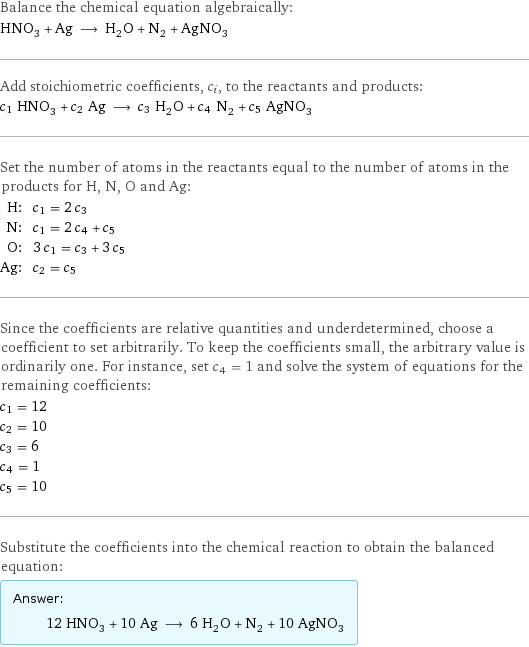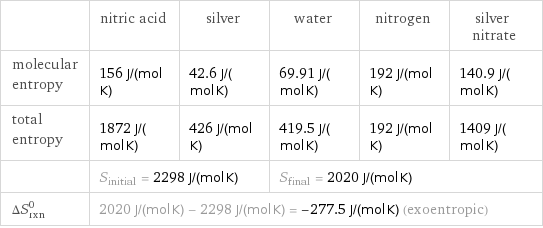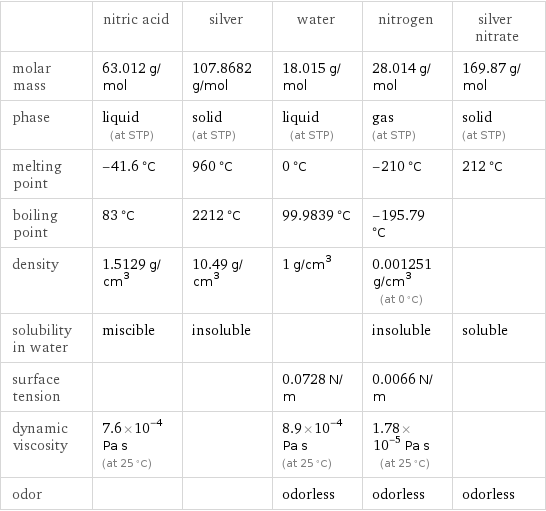Input interpretation

HNO_3 nitric acid + Ag silver ⟶ H_2O water + N_2 nitrogen + AgNO_3 silver nitrate
Balanced equation

Balance the chemical equation algebraically: HNO_3 + Ag ⟶ H_2O + N_2 + AgNO_3 Add stoichiometric coefficients, c_i, to the reactants and products: c_1 HNO_3 + c_2 Ag ⟶ c_3 H_2O + c_4 N_2 + c_5 AgNO_3 Set the number of atoms in the reactants equal to the number of atoms in the products for H, N, O and Ag: H: | c_1 = 2 c_3 N: | c_1 = 2 c_4 + c_5 O: | 3 c_1 = c_3 + 3 c_5 Ag: | c_2 = c_5 Since the coefficients are relative quantities and underdetermined, choose a coefficient to set arbitrarily. To keep the coefficients small, the arbitrary value is ordinarily one. For instance, set c_4 = 1 and solve the system of equations for the remaining coefficients: c_1 = 12 c_2 = 10 c_3 = 6 c_4 = 1 c_5 = 10 Substitute the coefficients into the chemical reaction to obtain the balanced equation: Answer: | | 12 HNO_3 + 10 Ag ⟶ 6 H_2O + N_2 + 10 AgNO_3
Structures

+ ⟶ + +
Names

nitric acid + silver ⟶ water + nitrogen + silver nitrate
Reaction thermodynamics
Entropy

| nitric acid | silver | water | nitrogen | silver nitrate molecular entropy | 156 J/(mol K) | 42.6 J/(mol K) | 69.91 J/(mol K) | 192 J/(mol K) | 140.9 J/(mol K) total entropy | 1872 J/(mol K) | 426 J/(mol K) | 419.5 J/(mol K) | 192 J/(mol K) | 1409 J/(mol K) | S_initial = 2298 J/(mol K) | | S_final = 2020 J/(mol K) | | ΔS_rxn^0 | 2020 J/(mol K) - 2298 J/(mol K) = -277.5 J/(mol K) (exoentropic) | | | |
Equilibrium constant
![Construct the equilibrium constant, K, expression for: HNO_3 + Ag ⟶ H_2O + N_2 + AgNO_3 Plan: • Balance the chemical equation. • Determine the stoichiometric numbers. • Assemble the activity expression for each chemical species. • Use the activity expressions to build the equilibrium constant expression. Write the balanced chemical equation: 12 HNO_3 + 10 Ag ⟶ 6 H_2O + N_2 + 10 AgNO_3 Assign stoichiometric numbers, ν_i, using the stoichiometric coefficients, c_i, from the balanced chemical equation in the following manner: ν_i = -c_i for reactants and ν_i = c_i for products: chemical species | c_i | ν_i HNO_3 | 12 | -12 Ag | 10 | -10 H_2O | 6 | 6 N_2 | 1 | 1 AgNO_3 | 10 | 10 Assemble the activity expressions accounting for the state of matter and ν_i: chemical species | c_i | ν_i | activity expression HNO_3 | 12 | -12 | ([HNO3])^(-12) Ag | 10 | -10 | ([Ag])^(-10) H_2O | 6 | 6 | ([H2O])^6 N_2 | 1 | 1 | [N2] AgNO_3 | 10 | 10 | ([AgNO3])^10 The equilibrium constant symbol in the concentration basis is: K_c Mulitply the activity expressions to arrive at the K_c expression: Answer: | | K_c = ([HNO3])^(-12) ([Ag])^(-10) ([H2O])^6 [N2] ([AgNO3])^10 = (([H2O])^6 [N2] ([AgNO3])^10)/(([HNO3])^12 ([Ag])^10)](../image_source/3a2224abe4e5d3e85025e1ea7525124d.png)
Construct the equilibrium constant, K, expression for: HNO_3 + Ag ⟶ H_2O + N_2 + AgNO_3 Plan: • Balance the chemical equation. • Determine the stoichiometric numbers. • Assemble the activity expression for each chemical species. • Use the activity expressions to build the equilibrium constant expression. Write the balanced chemical equation: 12 HNO_3 + 10 Ag ⟶ 6 H_2O + N_2 + 10 AgNO_3 Assign stoichiometric numbers, ν_i, using the stoichiometric coefficients, c_i, from the balanced chemical equation in the following manner: ν_i = -c_i for reactants and ν_i = c_i for products: chemical species | c_i | ν_i HNO_3 | 12 | -12 Ag | 10 | -10 H_2O | 6 | 6 N_2 | 1 | 1 AgNO_3 | 10 | 10 Assemble the activity expressions accounting for the state of matter and ν_i: chemical species | c_i | ν_i | activity expression HNO_3 | 12 | -12 | ([HNO3])^(-12) Ag | 10 | -10 | ([Ag])^(-10) H_2O | 6 | 6 | ([H2O])^6 N_2 | 1 | 1 | [N2] AgNO_3 | 10 | 10 | ([AgNO3])^10 The equilibrium constant symbol in the concentration basis is: K_c Mulitply the activity expressions to arrive at the K_c expression: Answer: | | K_c = ([HNO3])^(-12) ([Ag])^(-10) ([H2O])^6 [N2] ([AgNO3])^10 = (([H2O])^6 [N2] ([AgNO3])^10)/(([HNO3])^12 ([Ag])^10)
Rate of reaction
![Construct the rate of reaction expression for: HNO_3 + Ag ⟶ H_2O + N_2 + AgNO_3 Plan: • Balance the chemical equation. • Determine the stoichiometric numbers. • Assemble the rate term for each chemical species. • Write the rate of reaction expression. Write the balanced chemical equation: 12 HNO_3 + 10 Ag ⟶ 6 H_2O + N_2 + 10 AgNO_3 Assign stoichiometric numbers, ν_i, using the stoichiometric coefficients, c_i, from the balanced chemical equation in the following manner: ν_i = -c_i for reactants and ν_i = c_i for products: chemical species | c_i | ν_i HNO_3 | 12 | -12 Ag | 10 | -10 H_2O | 6 | 6 N_2 | 1 | 1 AgNO_3 | 10 | 10 The rate term for each chemical species, B_i, is 1/ν_i(Δ[B_i])/(Δt) where [B_i] is the amount concentration and t is time: chemical species | c_i | ν_i | rate term HNO_3 | 12 | -12 | -1/12 (Δ[HNO3])/(Δt) Ag | 10 | -10 | -1/10 (Δ[Ag])/(Δt) H_2O | 6 | 6 | 1/6 (Δ[H2O])/(Δt) N_2 | 1 | 1 | (Δ[N2])/(Δt) AgNO_3 | 10 | 10 | 1/10 (Δ[AgNO3])/(Δt) (for infinitesimal rate of change, replace Δ with d) Set the rate terms equal to each other to arrive at the rate expression: Answer: | | rate = -1/12 (Δ[HNO3])/(Δt) = -1/10 (Δ[Ag])/(Δt) = 1/6 (Δ[H2O])/(Δt) = (Δ[N2])/(Δt) = 1/10 (Δ[AgNO3])/(Δt) (assuming constant volume and no accumulation of intermediates or side products)](../image_source/328042eeb8f82805d75c58d7269ad628.png)
Construct the rate of reaction expression for: HNO_3 + Ag ⟶ H_2O + N_2 + AgNO_3 Plan: • Balance the chemical equation. • Determine the stoichiometric numbers. • Assemble the rate term for each chemical species. • Write the rate of reaction expression. Write the balanced chemical equation: 12 HNO_3 + 10 Ag ⟶ 6 H_2O + N_2 + 10 AgNO_3 Assign stoichiometric numbers, ν_i, using the stoichiometric coefficients, c_i, from the balanced chemical equation in the following manner: ν_i = -c_i for reactants and ν_i = c_i for products: chemical species | c_i | ν_i HNO_3 | 12 | -12 Ag | 10 | -10 H_2O | 6 | 6 N_2 | 1 | 1 AgNO_3 | 10 | 10 The rate term for each chemical species, B_i, is 1/ν_i(Δ[B_i])/(Δt) where [B_i] is the amount concentration and t is time: chemical species | c_i | ν_i | rate term HNO_3 | 12 | -12 | -1/12 (Δ[HNO3])/(Δt) Ag | 10 | -10 | -1/10 (Δ[Ag])/(Δt) H_2O | 6 | 6 | 1/6 (Δ[H2O])/(Δt) N_2 | 1 | 1 | (Δ[N2])/(Δt) AgNO_3 | 10 | 10 | 1/10 (Δ[AgNO3])/(Δt) (for infinitesimal rate of change, replace Δ with d) Set the rate terms equal to each other to arrive at the rate expression: Answer: | | rate = -1/12 (Δ[HNO3])/(Δt) = -1/10 (Δ[Ag])/(Δt) = 1/6 (Δ[H2O])/(Δt) = (Δ[N2])/(Δt) = 1/10 (Δ[AgNO3])/(Δt) (assuming constant volume and no accumulation of intermediates or side products)
Chemical names and formulas

| nitric acid | silver | water | nitrogen | silver nitrate formula | HNO_3 | Ag | H_2O | N_2 | AgNO_3 name | nitric acid | silver | water | nitrogen | silver nitrate IUPAC name | nitric acid | silver | water | molecular nitrogen | silver nitrate
Substance properties

| nitric acid | silver | water | nitrogen | silver nitrate molar mass | 63.012 g/mol | 107.8682 g/mol | 18.015 g/mol | 28.014 g/mol | 169.87 g/mol phase | liquid (at STP) | solid (at STP) | liquid (at STP) | gas (at STP) | solid (at STP) melting point | -41.6 °C | 960 °C | 0 °C | -210 °C | 212 °C boiling point | 83 °C | 2212 °C | 99.9839 °C | -195.79 °C | density | 1.5129 g/cm^3 | 10.49 g/cm^3 | 1 g/cm^3 | 0.001251 g/cm^3 (at 0 °C) | solubility in water | miscible | insoluble | | insoluble | soluble surface tension | | | 0.0728 N/m | 0.0066 N/m | dynamic viscosity | 7.6×10^-4 Pa s (at 25 °C) | | 8.9×10^-4 Pa s (at 25 °C) | 1.78×10^-5 Pa s (at 25 °C) | odor | | | odorless | odorless | odorless
Units
